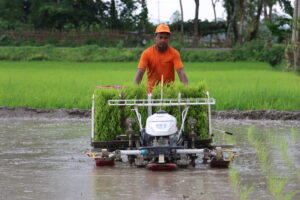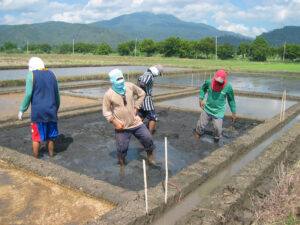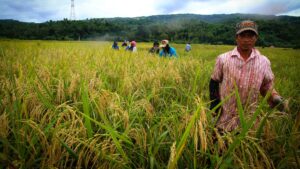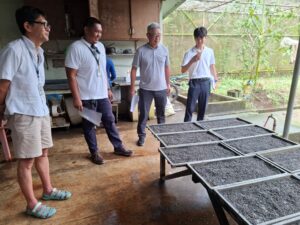The technology promises to accelerate the development of rice varieties that meet consumer preferences, enhance nutritional value, and contribute to global food security.
By Dr. Rhowell Tiozon and Glenn Concepcion
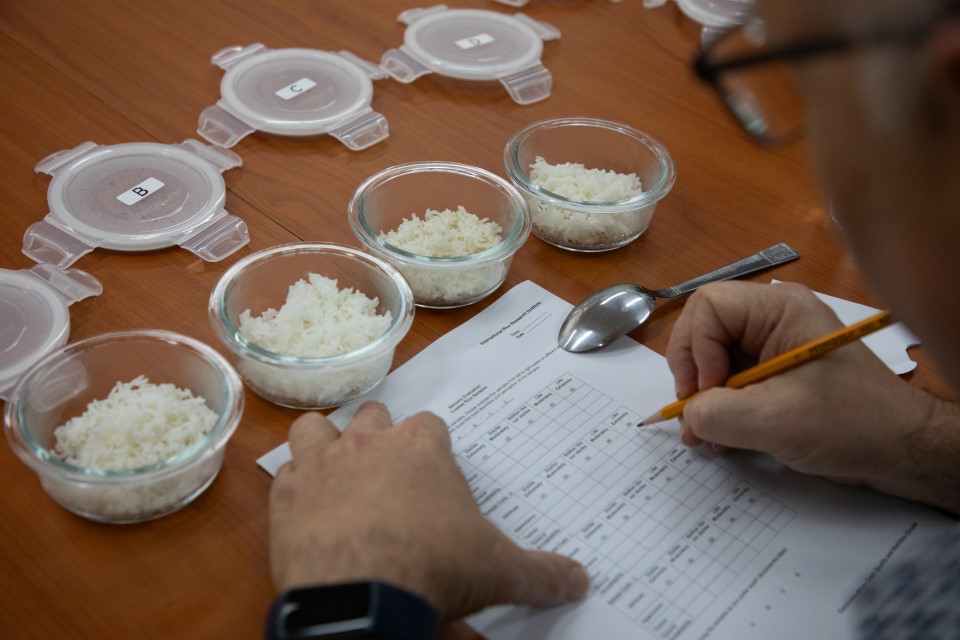
Over 3.5 billion people, particularly in Asia and Africa, rely on rice for a significant portion of their caloric intake every day, making its quality and nutrition critical for health and well-being. However, the science of rice breeding has traditionally focused more on yield, sometimes at the expense of grain quality and nutrition. This reflects the fact that key traits like texture, flavor, and nutritional content are influenced by intricate genetic and metabolic networks, which have long posed challenges for breeders due to their complexity and the limitations of earlier technologies.
Recent research by IRRI scientists and their collaborators have employed advanced breeding technologies and machine learning to unlock insights from large-scale datasets on rice chemistry, genetics, and sensory attributes, shedding light on the intricate factors that contribute to both the nutritional content and palatability of rice. This research recognizes the key role of consumer preferences and nutritional value in rice breeding, expanding beyond traditional yield-focused approaches, and leverages the power and potential of artificial intelligence, high-throughput phenotyping, and genomic analysis to accelerate the development of rice varieties that meet diverse regional demands and combat malnutrition.
Predicting cooking and textural quality through viscosity and starch data
In a breakthrough study1 from 2021, scientists developed a novel two-layered model combining starch polymer properties and viscosity measurements to predict Cooking and Eating Quality (CEQ) with exceptional precision.
Researchers analyzed 1,741 rice samples spanning diverse genetic backgrounds (including Indica and Japonica subspecies) using a rapid visco-analyzer (RVA) instrument to capture starch pasting and viscosity profiles during cooking. The RVA data reflect key texture attributes such as hardness and stickiness that influence consumer acceptance. Using Random Forest (RF) machine learning—algorithms that use an ensemble of decision trees to make predictions—the study classified rice grains into 12 distinct CEQ ideotypes, each representing a unique texture and sensory profile preferred in different regions. The primary model layer predicted seven broad CEQ classes based on RVA data, achieving an overall accuracy of 96.4%, and demonstrated good generalizability across various rice types and growing conditions. Adding starch molecular structure data from size-exclusion chromatography refined the classification to 12 ideotypes, achieving 93.5% accuracy.

Sensory panels confirmed the model’s ability to capture nuanced texture traits such as cohesiveness, springiness, and toothpack, linking objective viscosity measures to human perception. Furthermore, genome-wide association studies have identified key genetic markers linked to starch and protein traits that influence CEQ, achieving an 81% accuracy in predicting CEQ classes from DNA data alone. These can help enable breeders to select lines that match consumer texture preferences while maintaining high yield and adapting to local tastes.
Determining nutritional profiles enhanced by germination
A paper2 published in Communications Biology turned to metabolomics combined with machine learning to understand how germination—the process of a plant sprouting from a seed—boosts nutritional value in pigmented rice varieties known for their health benefits.
Germination has been shown to increase free phenolics and essential micronutrients such as calcium, sodium, iron, and zinc, and vitamins such as riboflavin and biotin. The study profiled 293 pigmented rice lines, showing how gamma-aminobutyric acid (GABA) increased up to 80.2 mg per 100 g in some purple pigmented varieties post-germination.

Metabolomic analysis identified hundreds of metabolites, revealing enhanced biosynthesis of flavonoids important for antioxidant effects. Using RF classification on metabolite, vitamin, and mineral data, four nutritional clusters of germinated rice were distinguished with 89.7% accuracy, while incorporating genetic markers related to flavonoid biosynthesis increased prediction accuracy to 97.7%.
This integrative approach enables the development of functional rice varieties with tailored multi-nutritional profiles, providing a roadmap for breeding programs aiming to combat hidden hunger and diet-related chronic diseases. The substantial increase in GABA, flavonoids, and micronutrients also supports product development of nutrient-rich germinated rice, ideal for health-conscious consumers. Moreover, the reduction of antinutritional compounds like proanthocyanidins during germination improves mineral bioavailability, reinforcing the potential of this bioprocess in the reduction of antinutritional factors and enhancement of nutritional efficacy.
Classifying subspecies-specific mineral profiles and donor lines
Focusing on the elemental composition of rice grains, a research article3 applied comprehensive mineral profiling and machine learning to classify over 1,100 rice accessions from diverse subspecies.
The data revealed striking differences in mineral content. Temperate Japonica varieties tend to accumulate higher concentrations of key minerals like iron, zinc, and copper, while Indica varieties generally have lower mineral levels but higher amylose content. Machine learning models classified the rice into three ionomic groups with prediction accuracies up to 85.1%.

Notably, novel donor rice lines with elevated concentrations of multiple essential minerals were identified, some surpassing current zinc-biofortified cultivars. These high-mineral donors also exhibited low levels of toxic elements such as arsenic and cadmium, which is important for food safety. The study also confirmed correlations such as negative relationships between amylose content and iron levels, and positive correlations among protein content and minerals like sulfur, zinc, and iron, highlighting the complex interplay between grain composition and nutrition.
These AI ionomic models provide a way to accelerate biofortified rice breeding with safe, nutrient-dense grains, which can help address micronutrient deficiencies prevalent in rice-dependent populations.
Implications for future rice breeding and global nutrition
Together, these three studies demonstrate the transformative power of artificial intelligence and machine learning in unraveling the complex genetics, chemistry, and physiology underlying rice grain quality and nutrition. Machine learning classifiers achieve above 90% accuracy in categorizing rice texture and nutritional ideotypes, while integrating genetic data enhances predictive power. These advances reduce reliance on costly sensory and biochemical assays and enable rapid, data-driven selection of rice varieties tailored for diverse consumer preferences and nutritional needs.
In practice, breeders can now use validated predictive models to screen the over 132,000 rice accessions in the IRRI Rice Genebank for optimal taste, texture, and health benefits early in the breeding cycle. This accelerates the development of rice varieties with premium market value due to superior cooking quality and nutrient content, while also enabling the identification of high-mineral donor lines to support biofortification efforts and address hidden hunger affecting billions worldwide.
The convergence of high-throughput phenotyping, genomics, and machine learning is opening new frontiers in crop improvement. By making grain quality and nutritional content more measurable, predictable, and breedable, these technologies promise a more nutritious and satisfying rice staple for the growing global population.
References:
1. Buenafe, R. J. Q., Kumanduri, V., & Sreenivasulu, N. (2021). Deploying viscosity and starch polymer properties to predict cooking and eating quality models: A novel breeding tool to predict texture. Carbohydrate Polymers, 260, 117766.
2. Tiozon, R. N. Jr., Sreenivasulu, N., & Fernie, A. R. (2023). Metabolomics and machine learning technique revealed that germination enhances the multi-nutritional properties of pigmented rice. Communications Biology, 6, 1000.
3. Tiozon, R. N., Buenafe, R. J. Q., Jain, V., Sen, P., Molina, L. R., Anacleto, R., & Sreenivasulu, N. (2024). Machine learning technique unraveled subspecies-specific ionomic variation with the preferential mineral enrichment in rice. Cereal Chemistry, 101, 367–381.


